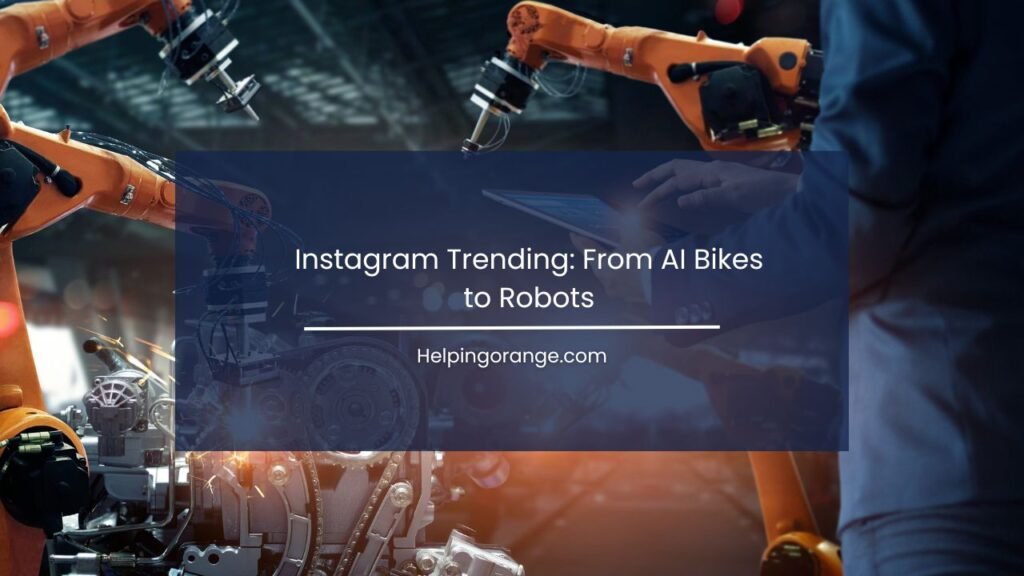In recent months, the blend of artificial intelligence and innovative design has shifted into high gear on social media, particularly on platforms like Instagram. One of the most talked-about trends is the evolution of AI bikes into robots.
This transformation represents not only technological advancements but a reimagining of how we interact with mobility and automation.

The Rise of AI Bikes
What Are AI Bikes?
AI bikes are bicycles equipped with smart technology that enhances the rider’s experience. These bikes incorporate sensors, GPS, and machine learning algorithms to provide features such as adaptive route planning, performance tracking, and personalized riding assistance. They’re gaining popularity amongst urban commuters and cycling enthusiasts who are looking for a higher-tech ride.
Instagram’s Role in Popularizing AI Bikes
Instagram has become the go-to platform for showcasing unique technological innovations, and AI bikes are no exception. Influencers and tech enthusiasts have flooded the platform with stunning visuals and engaging content surrounding their AI biking experiences. Hashtags like #AIBike and #SmartCycling have helped create a vibrant community sharing tips, reviews, and user-generated content.
PixVerse.ai – The Game Changer in AI-Driven Creative Solutions
In the fast-evolving world of artificial intelligence, tools that stand out not only enhance productivity but also ignite creativity. PixVerse.ai is one such tool that has garnered attention for its innovative approach to visual content creation.
Aimed at designers, marketers, and content creators, PixVerse.ai promises to redefine how we engage with images and graphics. Let’s dive into the key features, usability, and impact of this game-changing tool.
Key Features of PixVerse.ai
1. AI-Powered Image Generation
PixVerse.ai utilizes advanced generative algorithms to create stunning images based on user inputs. By simply entering keywords or phrases, users can receive unique, high-quality visuals that capture their intended essence.
This feature is particularly beneficial for those who may not have design skills but still require professional-grade graphics for their projects.
2. Versatile Customization Options
Beyond mere image generation, PixVerse.ai offers an array of customization tools. Users can modify colors, styles, and even elements within the images, allowing for a personalized touch that fits their brand or aesthetic needs. This flexibility ensures that even the generated images align perfectly with the user’s vision.
3. User-Friendly Interface
Navigating PixVerse.ai is a breeze, thanks to its intuitive interface. Whether you are a novice or an experienced designer, the layout simplifies the creative process, making it easy to experiment with different concepts. The learning curve is minimal, enabling users to start creating compelling visuals almost immediately.
4. Rapid Prototyping and Iteration
One of the standout features of PixVerse.ai is its ability to facilitate rapid prototyping. Users can generate multiple variations of an image in mere minutes, accelerating the brainstorming and refinement processes. This is especially advantageous for businesses needing to adapt quickly to market trends or campaign strategies.
Usability and Performance
Seamless Integration
PixVerse.ai can be easily integrated into existing workflows, whether it’s for social media, advertising, or web design. The tool supports various file formats, ensuring compatibility with popular design software and platforms.
Performance Analysis
In terms of performance PixVerse.ai delivers on its promises. The image generation is swift, and the quality remains consistently high. Users have reported minimal lag time, which enhances overall user experience and productivity.
Potential Challenges
Despite its many strengths, PixVerse.ai is not without its challenges.
Template Constraints
While customization is a benefit, some users may find that the template options are somewhat limited. Users looking for highly specific or niche designs may need to spend more time tweaking or combining elements to achieve their desired results.
Learning to Maximize Potential
While the interface is user-friendly, fully tapping into the tool’s features may require some initial exploration. New users might spend a little time experimenting before becoming proficient at leveraging the tool’s full potential.
Transition to Robot Technology
The Concept of Bike Robots
The next leap in this trend is transforming AI bikes into robots. These bike robots are designed to automate the biking experience completely. Imagine a bike that can navigate through traffic, avoid obstacles, and even find its way back to you if you step away or drop it off at a location. This futuristic idea leans heavily on advancements in robotics, sensors, and AI.
Features of Bike Robots
- Autonomous Navigation: Using advanced sensors and AI algorithms, bike robots can analyze their surroundings to navigate with precision.
- Remote Control: Many of these bikes allow for remote operation via an app, enabling users to control functions without physically being on the bike.
- Safety Mechanisms: AI algorithms continuously assess risks and can automatically apply brakes or steer away from potential accidents.
The Future: What Lies Ahead?
Integration with Urban Infrastructure
As more cities begin to prioritize smart transportation solutions, bike robots could become an integral part of urban infrastructure. Integrated with smart traffic signals and local transit, these AI-driven vehicles could help reduce congestion and improve overall transportation efficiency.
Potential Challenges
While the idea of bike robots is tantalizing, several obstacles remain. Issues regarding safety, legal regulations, and public acceptance must be addressed before these technological marvels can hit the streets. Moreover, concerns about the environmental impact and the carbon footprint of manufacturing these robots pose additional hurdles.
Conclusion
The transition from AI bikes to robot technology embodies the spirit of innovation that is flourishing in our world today. As Instagram continues to spotlight these advancements, it’s clear that the future of mobility is on the verge of a thrilling transformation. Whether you’re a tech enthusiast, an urban commuter, or simply curious about the future, the journey from AI bikes to bike robots is one worth following. The potential for increased efficiency, safety, and enjoyment of cycling is just on the horizon, and Instagram is undoubtedly leading the charge in this exciting narrative.
Stay tuned to your feeds—who knows what groundbreaking technology will pop up next!









